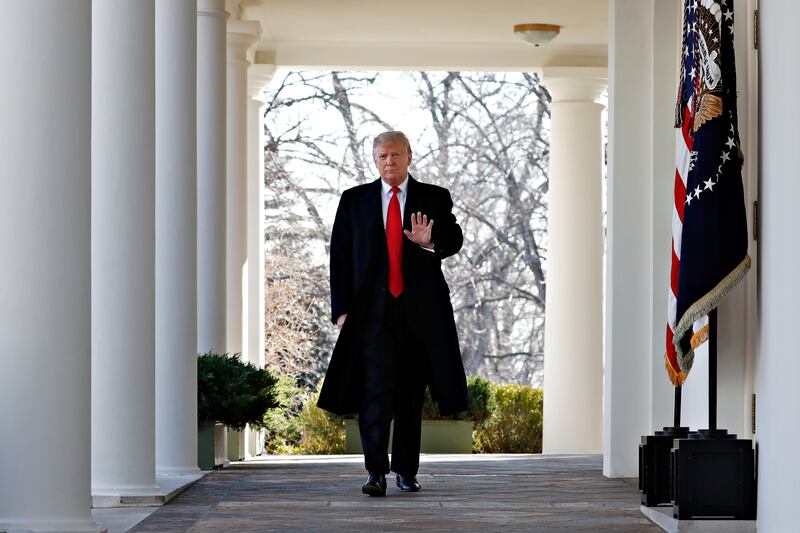SALT LAKE CITY — When President Donald Trump took office on Jan. 20, 2017, he promised to act boldly to make America wealthy, safe and great again.
“The time for empty talk is over. Now arrives the hour of action,” he said in his inaugural address.
One thousand days later, what action did he take?
House speaker Nancy Pelosi and many of her Democratic colleagues believe his actions warrant an impeachment investigation, and she called for one. His Republican supporters say that’s simply more of the same targeting of Trump the Democrats have done since day one as they sought a way to remove him from office.
The Deseret News set out to get beyond the impeachment debate and weigh the impact of the president and his administration on six key areas of public life: political discourse, religion, the economy, immigration, government institutions and the media.
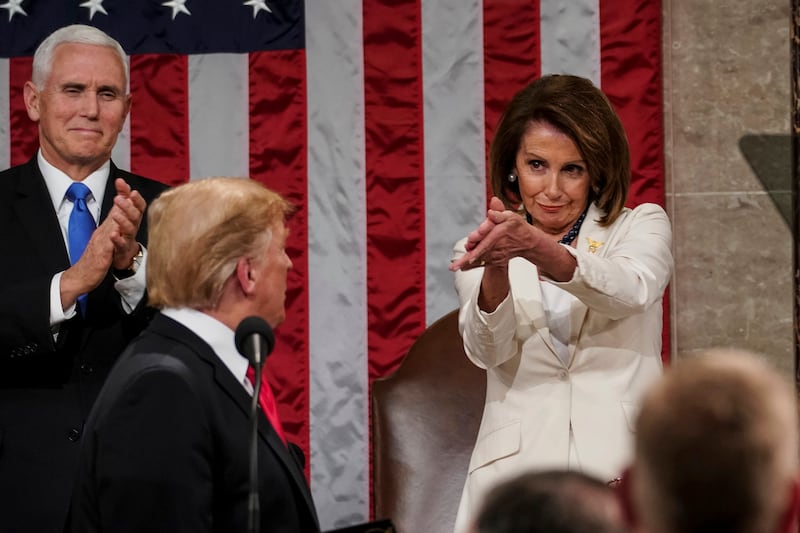
Political discourse
By Lois M. Collins
Part of President Donald Trump’s appeal to voters was his willingness to speak his mind without regard for propriety, public opinion or “political correctness.” One thousand days later, how has his candid presidency changed the country’s political discourse?
Supporters say they like the president’s free-wheeling, outspoken style and some even relish the fact that others find it offensive. Other Republicans seem willing to overlook his harsh words or rhetoric. Democrats and others on the left have frequently replied with shock and dismay. These positions are broadly reflected socially as well.
Constructive political conversations have largely stopped, according to a new Pew Research Center report that finds nearly three-fourths of American adults say Republicans and Democrats can’t agree on “basic facts.” Overwhelming majorities see the parties growing further apart — which three-fourths lament as harmful to the country.
Just over 60% of Americans describe both parties’ positions as “too extreme.” Democrats and Republicans view each other as “close-minded,” while Republicans also describe Democrats as “unpatriotic.”
The president bears some responsibility for deteriorating public discourse, since he makes “daily emotional appeals that cause anger and chaos and confusion and division among the American people as well as his world audience,” said Tim Chambless, an associate professor/adjunct at the University of Utah Osher Lifelong Learning Institute, noting “name-calling and constant negative allegations.”
In June, a whopping 85% of Americans polled by Pew Research Center said political discussion has become more negative in recent years. Significant majorities see the discourse as less respectful, less fact-based and less-substantive.
Respondents attribute much of that tenor to the Trump presidency. “A 55% majority says Trump has changed the tone and nature of political debate in this country for the worse; fewer than half as many (24%) say he has changed it for the better, while 20% say he has had little impact,” the report said.
Of the president’s communication style — including impromptu late-night tweets, insults of those who displease him and a tendency to veer off-topic with the press — the report noted “sizable majorities say Trump’s comments often or sometimes make them feel concerned (76%), confused (70%), embarrassed (69%) and exhausted (67%),” although 54% “at least sometimes feel entertained by what he says.”
The president’s style likely does contribute to how people talk to each other, said Ben Cook, law professor and director of the Brigham Young University Center for Conflict Resolution, which is hosting a workshop to help liberals and conservatives find common ground on Oct. 25. However, there are other sources of political vitriol, too.
Cook said technology has also changed how people talk about politics. “The biggest problem with social media is it allows us to dehumanize others,” he said. “I almost never see productive political discussions on Facebook, for example.”
Trump himself has often been described as “the Twitter president,” referring to his favored medium for broadcasting statements and opinions to his almost 66 million followers. His tweets, often off-the-cuff and laced with invective, have become part of the national conversation but especially seems to appeal to his base.
This kind of direct access, combined with an overall environment of fear as technology and other factors disrupt industries and threaten livelihoods, has fostered a different level of emotional connection for supporters of Trump and other politicians, Cook said. “On a bigger level, that spills over into politics, so you get people latching onto candidates in a way that ends up being more personal than it was in the past.”
At the same time, social media fosters arguments with strangers and friends of friends, but the platforms don’t offer basic communication cues important for constructive discussion, like tone or sarcasm. With emotionally fraught topics, Cook said, social media “ends up a lot of times being at least unproductive and often worse.”
Aggravating the matter, few people have firsthand information about politics, he said, noting the satirical The Onion during Barack Obama’s presidency ran this story: “Man who understands 8% of Obamacare vigorously defends it from man who understands 5%.”
“So many of us know so little about actual facts, but become emotionally attached to a position,” said Cook, who believes before deciding on something like whether Trump’s immigration policy is good or bad, people with different views should at least be able to agree what the policy is.
Labeling or dehumanizing the other side doesn’t help. “Most of the time, these are just issues reasonable people can disagree about,” Cook said. “They might be important issues, but we can’t just say the other side is evil and I’m going to shut them down, rather than try to understand them better.”
While Trump’s strategy seems to be working on a political level, it has also changed the White House’s role, once seen as an example of respect and inclusiveness.
Chambless laments the erosion of an Aristotelian idea of leadership, which calls for good character (ethos), clear logic (logos) and effective emotional appeals (pathos). “We long for the day when public discourse can once again be elevated and decent and civil,” he said
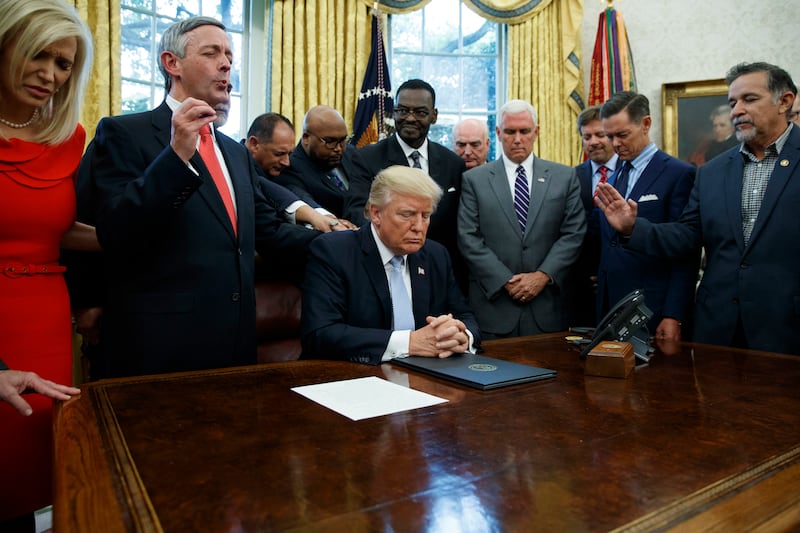
Religion
By Kelsey Dallas
President Donald Trump has kept many of his religion-related campaign promises, strengthening legal protections for people of faith and raising awareness of religious freedom violations around the world. His commitment to ending faith-based discrimination represents some of his most important work since taking office, according to religious freedom advocates.
“As president, protecting religious freedom is one of my highest priorities and always has been,” Trump said during an address to the United Nations on Sept. 23.
Trump has surrounded himself with people who prioritize religious liberty instead of treating it like a secondary concern, said Johnnie Moore, a commissioner for the U.S. Commission on International Religious Freedom who serves as one of the president’s evangelical Christian advisers.
“The president is using the full weight of the United States to force the issue of religious freedom on the agendas of world leaders,” he said in a statement tied to Trump’s United Nations remarks.
During the past 1,000 days, the Trump administration has hosted two gatherings on religious freedom at the State Department for high-level government leaders, provided more than $300 million in support to victims of the Islamic State and raised awareness of how legal protections for people of faith benefit all of society.
Trump and his team have used executive orders and administrative rule-making procedures to adjust which companies have to provide birth control to employees, enable health care workers with religious or moral objections to refuse to participate in controversial procedures like abortion and expand opportunities for religiously affiliated organizations to partner with the government.
In general, the Trump administration has recognized the importance of faith-based social service programs and worked to increase opportunities for religious groups to partner with the government, said Michael Wear, who worked on faith outreach for the Obama administration.
“There’s been positive engagement with faith communities around issues like opioid addiction and criminal justice reform,” he said.
These executive orders and outreach efforts corrected past administrations’ tendency to overlook the concerns of conservative people of faith, Wear added. However, they also exacerbated tensions over religious exemptions to nondiscrimination laws.
Religious freedom was a polarized issue long before Trump took office, but related debates have become even more contentious over the past three years, experts on religion and politics said. Democrats and Republicans increasingly spar over which faith groups deserve legal protection, choosing conflict over compromise.
“Religious freedom has become partisan instead of universal, a way to divide instead of unite,” said Asma Uddin, the author of “When Islam Is Not a Religion: Inside America’s Fight for Religious Freedom,” during a symposium on religion and inclusion at the Utah State Office Building in May.
This trend helps explain why the Trump administration’s efforts to protect people of faith overseas are often criticized, said Thomas Farr, president of the Religious Freedom Institute in Washington, D.C., to the Deseret News earlier this year. The cause of international religious freedom, which once enjoyed strong bipartisan support, is suffering as a result of domestic disputes.
It also suffers when Trump fails to defend all people of faith equally. He speaks often about the needs of persecuted Christians, but has pursued policies, like a ban on travelers from a handful of Muslim-majority countries, that harm members of minority faiths, said Shaun Casey, director of the Berkley Center for Religion, Peace and World Affairs at Georgetown University, in March.
“If you look at the actual, concrete policies of this administration, there’s a clear anti-Muslim bias and a clear pro-fundamentalist Christian bias,” he said.
Unless Trump can address critiques like these and reduce the polarization surrounding religious freedom, his legacy may be sparking debates over religion’s role in the public square instead of resolving them, said Wear, noting that some of the Trump administration’s religion-related orders and rules have already been challenged in court.
The executive orders and administrative rules implemented so far may be untenable in the long run and “far too sweeping to stay in place,” he said.

The economy
By Sofia Jeremias
As a candidate, President Donald Trump promised to energize the economy, leveraging his business acumen and experience with making deals to benefit American businesses and blue-collar workers alike. What steps has he taken to realize his vision, and how does the economy look now?
In his first 1,000 days, Trump has torn up and renegotiated trade deals, used executive orders to roll back regulations and taken up a major trade war with China. His signature win in Congress, the 2017 Tax Cuts and Jobs Act, cut taxes on corporations and the wealthy.
And business is booming. Stocks are strong, with the NYSE Composite Index hovering around 13,000 after hitting a record 13,637.02 in Jan. 2018. Unemployment dropped to 3.5% in September, the lowest since 1969. GDP grew a respectable 2 percent in the second quarter.
Trump took credit in this year’s State of the Union address. “In just over two years since the election, we have launched an unprecedented economic boom — a boom that has rarely been seen before,” he said.
But it is a truism that presidents get too much credit when the economy grows and too much blame when it slows. Princeton economist and former Federal Reserve vice president Alan Blinder takes the longer view, arguing in the Wall Street Journal that the economy is on a 10-year tear of uninterrupted growth he called the “Obama-Trump Economic Expansion.”
Policies have changed, but bull markets, employment and GDP have grown consistently since the Great Recession bottomed out in 2009, according to data compiled by CNN.
“When you’re trying to move a giant supertanker like the U.S. economy, you can only have a limited effect,” explained Paul Sheard, a senior fellow at Harvard’s Mossavar-Rahmani Center for Business and Government and former vice-chairman of S&P Global. The most direct way a president can affect the economy is by setting the mood with a “can-do spirit.”
Beyond boosterism, Trump has delivered on several key policy initiatives intended to benefit the economy, with mixed results.
Slashing regulations helped add 600,000 manufacturing jobs over Trump’s first two years in office, but the sector has now entered recession, according to the Los Angeles Times.
Coal mining jobs remain plateaued, according to the Bureau of Labor Statistics, despite removing environmental safeguards. It reports that coal production in Wyoming, the country’s top coal-producing state, is down, and coal mining employment there dropped 13% in the past year.
Partial repeal of the Dodd-Frank Wall Street Reform and Consumer Protection Act benefited community banks, whose shares rose 25% in 2018, according to CNBC. Critics worry this risks repeating certain issues that helped lead to the Great Recession.
Trump has scrapped two major trade deals; renegotiated one; slapped tariffs on allies such as Mexico, Canada and the European Union; and engaged in a trade war with China. The final outcomes remain unresolved, but critics argue consumers are bearing the costs. Trump has issued $28 billion in aid to alleviate the impact on farmers, notes the New York Times.
The 2017 Tax Cuts and Jobs Act reduced the corporate tax rate from 23.4% to 12.1% and individual income taxes from 9.6% to 9.2%, according to a report from the Congressional Research Service, and has given the economy a small short-term boost at a long-term cost.
“The tax reform was needed and helpful to the economy and extended the expansion,” said Natalie Gochnour, associate dean in the David Eccles School of Business at the University of Utah. “But it comes at a cost, because we are hitting record deficits. We’ll have a trillion dollars in deficit this year.”
Gochnour worries that when interest rates eventually rise, servicing the debt will limit the government’s ability to invest in infrastructure and human capital. “The deficit is not the wolf at the door, but the termites in the woodwork,” she said. “The idea is that it’s not going to blow our house down, but it’s eating at the foundation of our long-term economic health.”
Trump’s biggest challenge moving forward could be inspiring confidence in the economy, especially among consumers. Wage growth has remained just a tick above inflation, according to Business Insider, which also reported that a recent MetLife survey found 51% believed a recession was imminent and that they did not feel prepared.
“No question that this economy is rewarding people at the higher ends of the income scale,” Gochnour said. “It will become increasingly important to find ways to help people that this economy doesn’t have a place for.”

Immigration
By Erica Evans
In 1,000 days, the Trump administration has constructed 71 miles of new border wall, upended the asylum process, reduced the number of refugees allowed to enter the country to a historic low, removed protections for undocumented people living in the U.S. and proposed a merit-based immigration system.
A surge of migrants from Central America earlier this year put a strain on border resources and created what acting U.S. Customs and Border Protection commissioner Mark Morgan called a “humanitarian crisis.” The crisis peaked in May with 144,000 border apprehensions. But since then, the White House reported the number has declined by more than 60%. Morgan credits initiatives like the Migrant Protection Protocols or “Remain in Mexico” policy.
“The administration efforts — they’re working,” he said at an Oct. 8 press briefing.
On the other hand, Muzaffar Chishti, director of Migration Policy Institute’s office at NYU School of Law, said Trump’s policies are negatively affecting hundreds of thousands of lives. Many undocumented individuals without criminal records, who would have been safe from deportation three years ago, are now being removed. At the border, desperate families seeking refuge are unable to enter the country, said Chishti.
“The harm is real,” he said.
While public concern over immigration issues has grown since President Donald Trump was elected, the subject remains as divisive as ever, said James Carafano, vice president for national security and foreign policy at The Heritage Foundation, a nonprofit conservative think tank.
“Because it’s a top-tier issue and because of the divisive political environment, the impetus for the two sides is to draw the distinctions rather than to look for common ground,” he said.
The wall: By the end of 2020, U.S. Customs and Border Protection expects that approximately 450 miles of new wall will be constructed along the southern border. Facing opposition from Congress over funding for the wall, Trump signed a declaration of national emergency that allowed him to divert money allocated for other purposes.
Morgan said a physical barrier is “essential to our nation’s border security.”
Chishti, however, said the wall is more symbolic than strategic. “Building the wall is an important narrative line from Trump’s campaign. It is symbolic in telling the world that the day of America being welcoming is over.”
Asylum: In January 2019, the administration began the “Remain in Mexico” program. Under that program, more than 51, 000 people who were hoping to claim asylum in the U.S. have been returned to Mexico to await court dates. The problem, critics say, is the safety of asylum-seekers cannot be guaranteed in Mexican border cities where gang members prey on vulnerable migrants.
But Carafano said “Remain in Mexico” is effective because it has eliminated incentives for asylum-seekers to cross the border if their case is unlikely to succeed.
In addition, the Trump administration has negotiated agreements with Guatemala, El Salvador and Honduras with the goal to encourage those countries to provide protection to more asylum-seekers instead of the United States. However, these are precisely the countries many are fleeing.
Refugees: In September, the Trump administration announced a plan to reduce refugee admissions to 18,000, the lowest since the resettlement program was created in 1980.
“We have completely given up on our obligations to the refugees. We are known as the country of refuge. That has been our history,” said Chishti.
Andrew Arthur, a resident fellow in law and policy at the Center for Immigration Studies in Washington, D.C., said U.S. funding could better be used to assist the world’s 25.9 million refugees abroad, instead of resettling a small percentage in an expensive country like the United States.
Interior: Upon taking office, Trump directed U.S. agencies to execute immigration laws against all unauthorized noncitizens, a dramatic departure from the Obama administration’s focus on criminals and recent border crossers.
“Now we are picking people with no criminal record and people who have been here for long periods of time,” said Chishti. “It’s heartbreaking.”
Trump also announced the rescission of Obama-era programs like Deferred Action for Childhood Arrivals (DACA), which provides work authorization and temporary relief from deportation to people brought to the United States as children. The president said he would support legislation to replace DACA, as long as Congress made it part of a broader immigration overhaul that would include funding for a border wall. Congress and the White House have repeatedly failed to agree on a DACA-for-wall deal. Today, DACA remains in effect pending court outcomes, but the government is not accepting new applications.
Merit: Looking forward, Trump wants to move the United States away from a family based immigration system toward one that favors applicants with desirable labor market attributes, to be selected based on a points system.
“These reforms will advance the safety and prosperity of all Americans while helping new citizens assimilate and flourish,” reads the White House website.
But at the end of the day, all of it could be reversed.
“If a new president is elected, they will essentially feel like they have a mandate and a requirement to undo all the things that Trump did,” said Carafano.
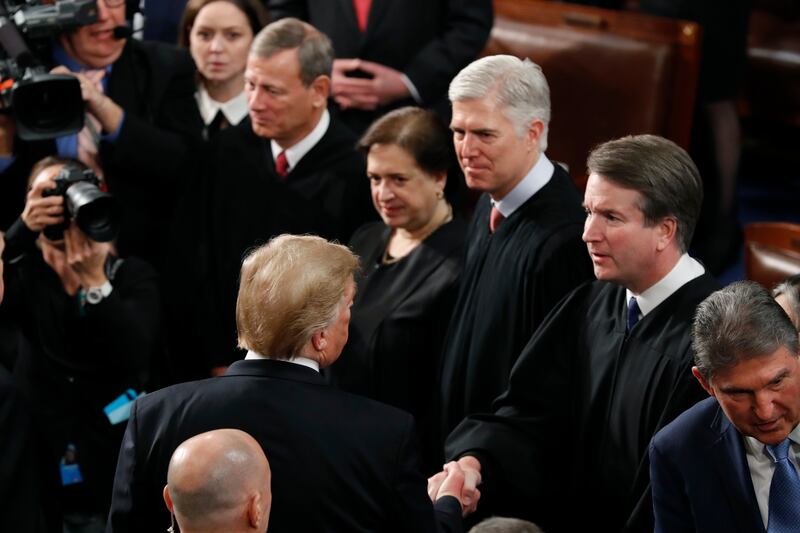
Government institutions
By Lois M. Collins
Contention has swirled around President Donald Trump’s relationships with various government institutions and how his presidency has impacted the public’s view of them during his first 1,000 days in office.
Claims the Supreme Court has become too partisan, lethargic voter approval of Congress and concern about attempts by Russia to influence American elections and the security of future votes are among government relationships scrutinized through that particular lens.
Some of the issues arose well before Trump’s election. For instance, Gallup has tracked approval — or disapproval — of how Congress does its job since the mid-1970s. The trend line to that question over three decades looks more like ventricular fibrillation than a nation’s steady heartbeat. The highest approval rating, 84%, came in October 2001, in the aftermath of terrorist attacks when George W. Bush was president. Low approval of Congress, 9%, was in November 2013 during Barack Obama’s presidency. Approval now hovers just under 20% in that poll.
Interactions between the president and Congress have been testy.
“We’ve seen a pretty high level of stonewalling by the executive branch,” said Molly E. Reynolds, a senior fellow in governance studies at Brookings Institution. Historically, Congress and the White House find a compromise that’s mutually acceptable, but they haven’t been compromising. If the Democrat-controlled House has to go to court to try to force compliance, government slows down.
Efforts to limit Congress’s ability to govern or to clash with White House policy are not new, either, said Reynolds, who said “what we are seeing is the continuation of a long pattern of executive branch dominance over the legislative branch” going back to the 1970s, with Congress sometimes showing a willingness to give up power and not make complicated policy choices.
One’s partisan politics — and how it matches who is in the White House — largely determines how one feels about that balance of power, Reynolds said.
As crucial as Congressional action is, The Hill contributor Max Burns has opined that “as clashes between the White House and Congress grow more acrimonious, the real political drama is unfolding at a whisper level at the Supreme Court, just a few blocks away.” How one views the high court seems largely driven by one’s partisan ideology, too, with conservatives praising it and others lambasting it as too political.
“President Trump obviously recognizes the benefit of being able to appoint justices and the political potency of the Supreme Court nomination within the political coalition that elected him,” said Adam White, a resident scholar at American Enterprise Institute and assistant professor of law at George Mason.
But White said it’s also clear the president doesn’t hesitate to lash out when a ruling displeases him. That’s happened on issues of asylum and the travel ban, among others. Instead of treating the Supreme Court with its due respect, he treats the court like “another political actor,” he added.
Chief Justice John Roberts politely clashed with the president’s dismissal of an unfavorable ruling last year as coming from an “Obama judge.” “What we have is an extraordinary group of dedicated judges doing their level best to do equal right to those appearing before them,” Roberts responded to an Associated Press question. He emphasized that the court is not tied to a political party, but rather to its duty.
But conservatives are clearly happier with the makeup of the Supreme Court than they were before Brett Kavanaugh was seated, while liberals believe accusations leveled against him prior to his confirmation should have prevented confirmation. Nor is the president the first to chide the court. Obama did that, facing the justices, during a State of the Union address, White said.
One of the most contentious issues came to a head in March with the release of Special Counsel Robert Mueller’s investigation into Russian interference with America’s presidential election. The probe concluded Russia interfered with the election “in sweeping and systematic fashion” by favoring the Trump campaign and discrediting the Clinton campaign. It did not conclude the Trump campaign conspired, though it established some links with members of his campaign. That election has raised the issue of what will be done to secure America’s electoral process from outsiders in 2020.
The number of vacant key positions within the government and a high turnover rate within the Trump administration have also fueled both criticism and speculation. Reynolds said the sheer number of vacancies can keep a government from operating smoothly. And having “acting” officials can bypass the confirmation process that shares power with Congress.
Meanwhile, the number of exits among the president’s key political advisors and vacancies within the executive branch have stirred well-publicized consternation. Each week, The Washington Post and the nonpartisan, nonprofit Partnership for Public Service update their scorecard on where or if nominations for key positions are in the confirmation process. On Oct. 7, of 734 positions, 495 had been confirmed, while 143 had no nominee, another 15 had been selected but not yet formally nominated and 81 were nominated but not yet confirmed. The share of key positions filled range from 41% in the Department of Homeland Security (which has an acting secretary) to 92% for the Department of Veterans Affairs. The database notes 87 confirmed individuals have resigned and 41 nominations were withdrawn by the president.
The Brookings Institution reported Trump’s “A-team” Turnover Is 80% as of Oct. 14, 2019. The “A-team” designation includes members of the president’s executive office, but not Cabinet secretaries. It is a single-position count, so the departure of Sean Spicer and Sarah Huckabee Sanders as press secretary, for example, counted as one exit, not two. Deputy National Security Advisor Matthew Pottinger is in the most-replaced senior-level position on the list; he’s sixth in that spot since Trump took office.
Appointee turnover is not unusual, but Time reported in July that when Labor Secretary Alex Acosta became the ninth to resign, Cabinet turnover in this administration had surpassed that of the whole first term of Trump’s most recent predecessors: “By comparison, six Cabinet secretaries departed during Reagan’s first term, eight during H.W. Bush’s presidency, four during Clinton’s first term, two during W. Bush’s first term and three during Obama’s first term.”
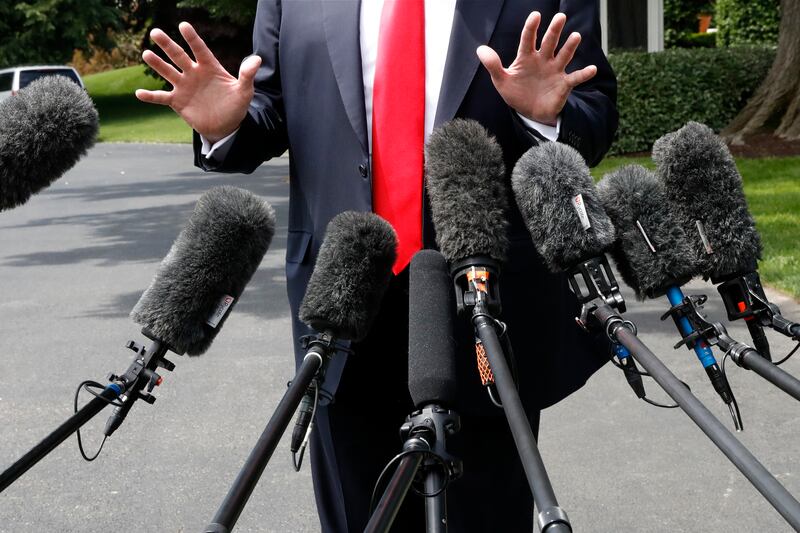
The media
By Gillian Friedman
On President Donald Trump’s first day in office, he told the CIA, “I have a running war with the media. They are among the most dishonest human beings on Earth.” He has called CNN “terrible” and BuzzFeed “garbage” and labeled the New York Times as a “failing” newspaper. He has tweeted that the media is “the enemy of the American People!”
And yet, Trump constantly engages with the media. He frequently stops to talk to the press before boarding his helicopter. He agrees to interviews with reporters. And he is a media innovator: he is the first president to take to Twitter to communicate directly (and daily) with the American people. A Pew Research Center analysis in July estimates that around one in five adult Twitter users in the U.S. (19%) follow his accounts; overall, 22% of U.S. adults say they use the platform.
“There is no other president who has operated that way,” said Cal Jillson, professor of political science at Southern Methodist University.
Is Trump an accessible populist president, using social media to speak directly to Americans, in the vein of President Franklin D. Roosevelt’s fireside chats? Or does he seek to undermine the credibility of the media to his own advantage, spreading misinformation to distract the press and the public?
The answer to that question depends on who you ask. The nation is divided into partisan camps, and the media landscape reflects such polarization. A 2017 Reuters Institute report revealed that U.S media polarization far exceeds that of any other Western country.
But a free press is not a partisan issue. It is a hallmark of American democracy, an institution designed to protect the people by holding the powerful accountable.
In the 1,000 days since he took office, has Trump fundamentally changed the relationship between the presidency and the press — and by extension, the public?
Historically, presidents have generally managed their relationship with the press and the public by streamlining communication, according to Jillson. But Trump has the opposite approach.
“He engages the media every day, several times a day,” said Jillson. “Trump will talk to the media about almost anything.”
Trump’s constant stream of tweets keeps the media distracted, overwhelming their ability to sort fact from fiction, said Jillson.
“We haven’t really learned how to cover Trump without being constantly distracted by the latest outrage, tweet or distraction,” Margaret Sullivan, former public editor of The New York Times and a media columnist for The Washington Post, said in an email in August. “Too often, he is the de facto assignment editor. And that’s far from ideal.”
“Trump plays media,” Al Tompkins, senior faculty at the Poynter Institute, told the Deseret News in August.
But if Trump plays the media, the media also plays Trump.
Subscriptions to the New York Times have soared since Trump’s election, and major cable news networks have profited from the ratings boost that coverage of the Trump administration provides.
”It may not be good for America, but it’s damn good for CBS,” CBS executive chairman and CEO Leslie Moonves told the Hollywood Reporter, referring to the ad money Trump has brought to the network.
That’s why Jillson says there’s a “love/hate relationship” between Trump and the media: while they denigrate one another, they are dependent on one another.
“It is indeed a codependent relationship. And it’s difficult to disrupt it,” said Theodore Glasser, professor emeritus of communication at Stanford University.
Yet the so-called “Trump bump” has put news organizations like The New York Times in a difficult spot. Any coverage perceived as negative toward the president is blasted by Trump as biased — but any coverage perceived as positive is condemned by loyal subscribers, prompting cries of #CancelNYT.
In the midst of a crisis of the journalism business model, in which media outlets across the country are struggling to stay afloat and every reader and every dollar counts, such criticism from all sides takes on a heightened significance.
Tompkins with Poynter said journalists in the Trump era must do more to incorporate the perspective of Trump supporters into their coverage.
“After the 2016 election, a lot of journalists said: ‘How did we not know that Trump had all of this support?’ The answer was, they didn’t listen,” he said. “I think it’s incumbent upon journalists to listen to what Trump supporters are saying and to find out why they are saying it.”
David Greenberg, professor of media studies at Rutgers University, says Trump’s presidency could have a profound, lasting effect on Americans’ attitudes toward the press.

